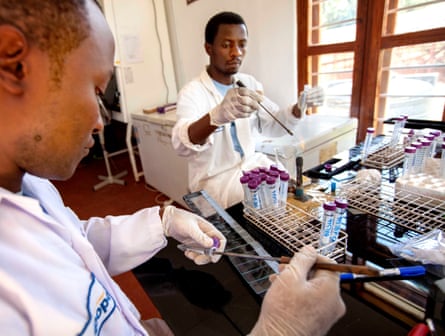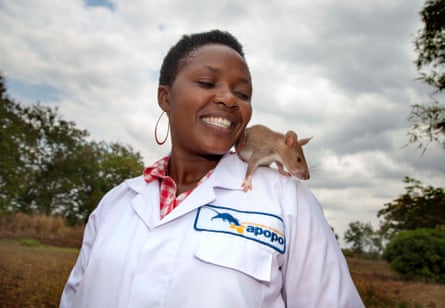After scampering about a sleek glass and aluminium cage, a rat named Riziwan has made a crucial discovery.
In just minutes, Riziwan has positively identified 13 people who may have tuberculosis. The discovery is potentially life-saving news for those whose sputum samples were marked as clear by their local health clinics. But it’s all in a day’s – or rather 15 minutes’ – work for Riziwan and the other giant African pouched rats that work at Belgian organisation Apopo’s TB centre in Morogoro, Tanzania.
Riziwan, now almost a year old, has been trained – almost since birth – to pick up the smell of the disease, which is notoriously difficult to detect.
To carry out his work, Riziwan is placed in a large cage. Into its base, technicians insert a metal bar holding 10 dishes of human sputum, sent to Apopo by a TB clinic. All samples have been heat-treated so there is no risk of infection to either rats or humans. One by one, metal grates in the bottom of the cage are opened to allow Riziwan to sniff each petri dish.
There is silence among the technicians as Riziwan examines the samples. He moves on quickly from slots one and two, but at the third he pauses and scratches the metal bottom of the cage, indicating that he smells the disease.
At the seventh hole he scratches again, and again at the eighth. This time Harumi Ramadhani, the training supervisor, presses a clicker, meaning Riziwan has correctly identified a control sample from one of the clinics. It earns him a reward of mashed banana, avocado and rat pellets.

In all, Riziwan checks 100 samples. His work done for the day, he is returned to a large open-air playpen. The cage is cleaned and a second rat – a female named Pink – is brought in to test his findings.
“No person will be treated only on the statement of a rat,” says Lena Fiebig, head of the TB programme at Apopo. “The rats at this moment are not approved as a standalone diagnostic tool. We’ll then use a recognised method, and this is mostly concentrated microscopy, where a lab technician will re-check these samples. But the rats have already contributed tremendously to narrowing down the focus, so it’s not a team of 10 lab technicians who need a week to re-check.”
On average, Apopo rats find an additional 40% of TB cases on top of those discovered by clinics. Since they started work 10 years ago, they have screened nearly half a million samples and detected more than 12,200 missed cases. They can get through 100 samples in 10 to 20 minutes: a human with a microscope takes four days to test the same number.
The World Health Organization estimates that last year 4.1m TB cases went undetected, despite it being the world’s top infectious killer in 2016, resulting in 1.7m deaths. Detection rates using conventional light microscopy – the technique used at the clinics that send samples to Apopo for checking – can be as low as 20%.
Tuberculosis is an obvious target for the keen-nosed rats. “It’s known, or perceived, that TB has a specific odour. Reportedly dogs would avoid patients’ rooms with the disease,” says Fiebig. “Even doctors have reported cases where they receive a smell off TB patients.”

The centre began training the rats on samples from the central TB laboratory for Tanzania, and the programme became operational in 2007. Apopo now partners with 57 clinics in Tanzania, and has operations in Mozambique and a centre about to open in Ethiopia.
“They are incredible,” says Ramadhani. “They can do a lot of things and they’re an easy animal to work with.”
Life is pretty good for the African pouched rats. At the end of the week – on “full-cheek Friday” – they are allowed to stuff their famous pouches with a feast. They live about eight or nine years and when they are too old to work are retired to the playpens.
The versatile species has also proved adept at detecting landmines. In the past 20 years, Apopo’s rats have found more than 100,000 landmines and unexploded ordinances, clearing 22m square metres of land in countries including Mozambique, Angola and Cambodia. The NGO hopes to send teams to Colombia and Zimbabwe next year.
Mine-clearing is still core to what Apopo does and in the early hours of one morning, handlers transport a dozen rats to a 24-hectare (29-acre) field where defused landmines have been buried for them to train with.
The animals, which are nocturnal and susceptible to sunburn, have their tails and ears slathered in clear sunscreen. They are fitted into harnesses, and methodically check every square inch of ground.
Burhani is being tested today. If he passes – scratching at the soil above every buried landmine – he will be sent to Angola to replace a rat nearing retirement. Werrason (named after a Congolese musician) is progressing well, but misses two mines, so is not yet ready to be deployed. The third, Chifupa (named after a late Tanzanian MP) is struggling. She is still on one of the smaller, easier training fields and misses about half of the mines buried in it. It will be some time before she catches up with the rest of her class.
The human de-miners must have complete faith in the rats’ ability. They are only allowed on to minefields when they can detect every explosive in the area during training, with only one false positive – compared with the tuberculosis rats, which are operational with a sensitivity rate of 75%.
After a piece of land has been cleared of mines, as part of the handover ceremony to the community, Apopo staff will run across it to prove to sceptical locals that it is safe.

Cindy Fast, head of Apopo’s training, research and development, is always on the lookout for more ways the animals might put their noses to good use. “We are just beginning to tap into their potential,” she says.
There is talk of using them in disaster zones, finding survivors buried in the rubble of collapsed buildings. And this week a group of rats began training to recognise the scent of African hardwoods as well as the scales of the pangolin, the most trafficked mammal in the world, so they can be used in anti-smuggling operations.
Slowly, these projects are turning rats from pests into heroes among locals.
“In the beginning it was very difficult to get people to understand what we’re doing,” says Shaibu Hamisi, one of the mine detection rat trainers. “People didn’t understand how the rodent could be useful.” He adds that there is still stigma around the animals.
The trainers miss their charges when they are sent abroad for different projects, Hamisi says, but “when we hear this rat has found two landmines today, we feel really proud”.
